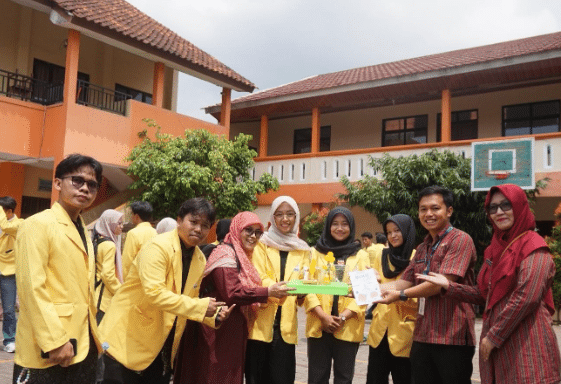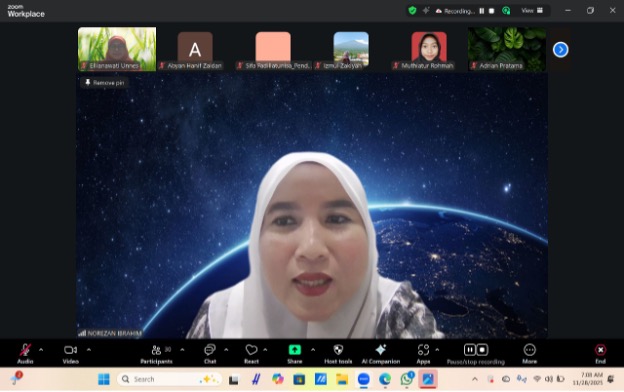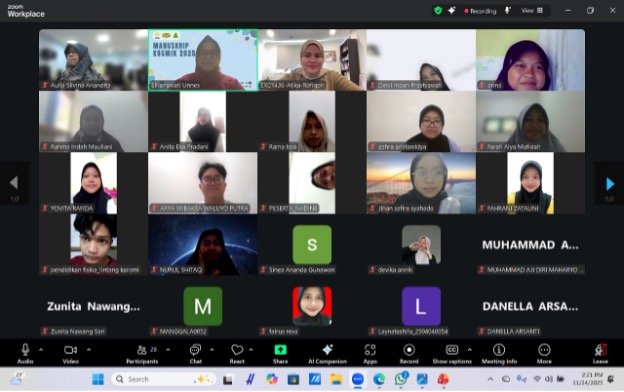 This idea is an idea that emerged based on the conditions of the development of the mathematics education laboratory so far. Over 20 years ago, the mathematics education laboratory has received visits from schools ranging from kindergarten to high school. Through visits to the laboratory, students are invited to learn and increase their knowledge of mathematics. The basic laboratory is equipped with various mathematics learning aids, the development laboratory has audio-visual media, supported by a computer laboratory. One of the highlights of the mathematics education laboratory is the presence of mathematics learning aids. The development of mathematics learning aids has been continuously carried out through major research activities. It is not only research, but the presence of courses (for example, Mathematics Education Media 1 and 2 courses) greatly supports the emergence of research ideas and community service. Through the implementation of the three pillars of higher education (teaching/lecturing-research-community service), these learning aids can continue to be developed following the times. Furthermore, research in mathematics education is also diverse, such as research on innovative learning models, teacher training models, prospective teacher learning models, visual and virtual media, which have been carried out by mathematics department lecturers. In addition, community service activities such as coaching the National Science Olympiad (OSN) in schools have also been conducted by lecturers who have expertise in this field. These activities are not incidental, but can be considered as programmed and routine activities. The results of teaching, research, and community service activities should also be published in tangible form. The community should not only read about them, but also see and experience them in reality.
This idea is an idea that emerged based on the conditions of the development of the mathematics education laboratory so far. Over 20 years ago, the mathematics education laboratory has received visits from schools ranging from kindergarten to high school. Through visits to the laboratory, students are invited to learn and increase their knowledge of mathematics. The basic laboratory is equipped with various mathematics learning aids, the development laboratory has audio-visual media, supported by a computer laboratory. One of the highlights of the mathematics education laboratory is the presence of mathematics learning aids. The development of mathematics learning aids has been continuously carried out through major research activities. It is not only research, but the presence of courses (for example, Mathematics Education Media 1 and 2 courses) greatly supports the emergence of research ideas and community service. Through the implementation of the three pillars of higher education (teaching/lecturing-research-community service), these learning aids can continue to be developed following the times. Furthermore, research in mathematics education is also diverse, such as research on innovative learning models, teacher training models, prospective teacher learning models, visual and virtual media, which have been carried out by mathematics department lecturers. In addition, community service activities such as coaching the National Science Olympiad (OSN) in schools have also been conducted by lecturers who have expertise in this field. These activities are not incidental, but can be considered as programmed and routine activities. The results of teaching, research, and community service activities should also be published in tangible form. The community should not only read about them, but also see and experience them in reality.
The usual objects presented during visits are observing the display of manipulative tools (concrete media), visual media, and virtual media in a limited manner. This limitation is due to the lack of proper management. When there is a request for a visit, it is prepared as “usual” at that time. The developed learning aids are not only for visitors (consumers) to observe but also for them to directly engage in using the learning aids. The developed learning aids go beyond helping students understand mathematical concepts/principles. Individual and group learning aids have been developed to stimulate children’s thinking processes and even develop their character. The Tangram-7 Puzzle game has not only been tested in research but also implemented in the community (such as the CSR Program of Petronas Carigali Muriah Ltd in the Tanjungmas Village, Lab. School UNNES, Parereja Village Children’s Forum in Brebes Regency, Mathematics Village in Karanganyar Regency, Raja Perempuan Tayah Ipoh School in Perak, Malaysia, and SMP N 22 Semarang). The involvement of visitors (students and teachers) in utilizing manipulative learning aids and games has been initiated for end-of-year visits in 2019. For example, the Tower of Hanoi Manipulative Learning Aid, a competitive group game that requires children to be tolerant, make quick decisions, respect others’ decisions, and work together.
The coaching for the National Science Olympiad (OSN) is generally intended for gifted children, which means that less fortunate children who do not pass the selection cannot participate in the OSN classes. Consequently, these children will never know what OSN is, what the questions are like, and how the selection process works. In the mathematics laboratory, it is possible to create simulated OSN classes or regular mathematics Olympiads organized by the Mathematics Student Association. Anyone interested in gaining experience and measuring their abilities can participate in simulated OSN classes or mathematics Olympiads in the mathematics laboratory. In this regard, students and teachers can also actively participate in gaining such experiences.
Practices of learning with visual and virtual media can be conducted by the community in the mathematics laboratory. The utilization of technology for learning, such as Augmented Reality, Virtual Reality, and the use of Android for MathCityMap, which has been developed by Dr. rer.nat. Adi Nur Cahyono, M.Pd., as a result of his study in Germany, can be implemented. There are still many potentials that can be developed from the existing resources in the mathematics laboratory, as well as the activities of students and lecturers.
The Mathematics Park with the Königsberg Bridge and Chinese Postman Problem can be optimized in terms of appearance and park utilization. With proper management from the Department of Mathematics and the Faculty of Mathematics and Natural Sciences, these existing potentials can not only be utilized as objects of interest for school visits but can also be prepared as innovative and commercial amazing attractions.
To realize the idea of the Amazing Mathematics Activity Area (AMA-A), several things need to be considered:
- Recognition of the existence and potential of the mathematics laboratory and its activities by the Department of Mathematics and the Faculty of Mathematics and Natural Sciences.
- Recognition of this existence and potential by the lecturers, students, as well as the educational and cleaning service staff.
- Identification of the existing potentials and their respective responsibilities.
- Establishment of an organizational structure as the commercial unit of AMA-A.
- Implementation of effective management to ensure sustainable development and product quality, including conducting SWOT analysis to prepare the product’s existence.
- Issuance of relevant policies or regulations.
In conclusion, I would like to emphasize that the Amazing Mathematics Activity Area can be designed to generate both direct and indirect income. However, it requires other supporting elements for indirect income.
| Dr. Isti Hidayah, M.Pd is a lecturer in the Department of Mathematics who focuses on the development of mathematics learning aids. Her research has reached the stage of industry commercialization and management studies. Currently, Isti Hidayah serves as the Coordinator of the Education Research and Community Service Unit and the Chairperson of the Graduate School Innovation and Commercialization Cluster. Additionally, Isti Hidayah has been a reviewer for the DRPM community service program since 2004 and an internal research reviewer (certified nationally). |




